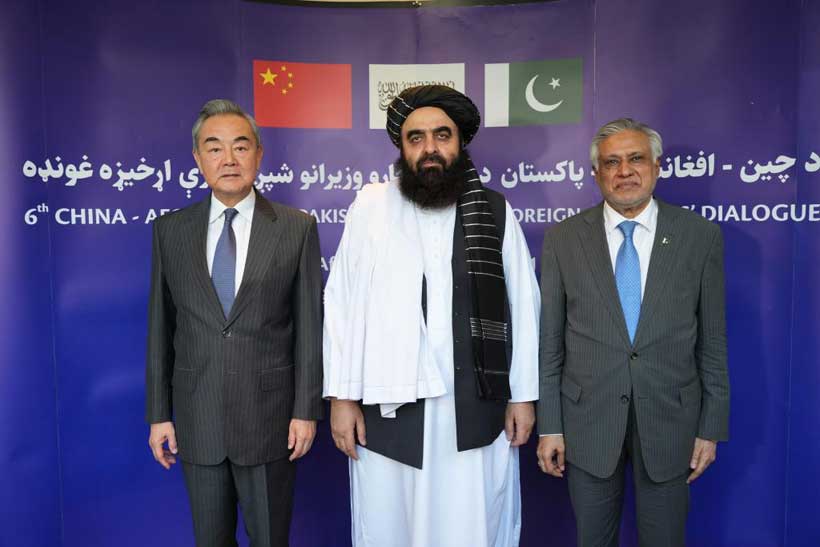It was no normal day in Kabul on the 20th of August 2025. The city, once ravaged by war and suspicion, welcomed an event that could redraw the region’s map, the sixth Pakistan-Afghanistan-China trilateral meeting. For decades, Afghanistan has been considered a theater of disorder, characterized by foreign interference, militancy, and sanctions.
In this groundbreaking round, China’s Foreign Minister Wang Yi’s attendance sent a message far beyond the confines of the conference room: Beijing stands ready to bet on Afghanistan’s revival from a battleground to a bridge economy. The Kabul session was no rerun of tired diplomatic protocol.
It was Afghanistan joining the China-Pakistan Economic Corridor (CPEC) officially, something that drastically alters the nation’s future along with the region’s geopolitics. By including Afghanistan in this paradigm, Pakistan and China have given the Taliban regime a once-in-a-lifetime chance to come out of seclusion, accrue legitimacy, and tap the economic potential. For a nation strangled by sanctions and bothered by unemployment, CPEC has the promise of something more than roads and pipelines; it has the promise of employment, commerce, and the chance to be an indispensable linkage between Central and South Asia.
Pakistan’s diplomacy has been at the center of making this day possible. For Islamabad, the addition of Afghanistan isn’t so much an act of goodwill and cooperation but also a hard security calculus. By adding Kabul to CPEC, Pakistan is minimizing the leeway for external actors, mainly India, to use the territory of Afghanistan for destabilization. It is also solidifying its own geo-economics hub, framing itself as a bridge state in a position to offer stability as well as connectivity. Primarily, Pakistan has shifted the instability of Afghanistan from a burden to a collective responsibility, with China’s financial influence footing the bill.
China has thus come to Kabul in a dual role: to mediate and to manage risk. Beijing knows that until stability arrives in Afghanistan, the projects under the Belt and Road Initiative stand to be jeopardized. The risks are genuine. Terror entities such as the TTP, ISKP, Al-Qaeda, and ETIM pose direct threats to the lives of citizens in China, CPEC projects, and internal stability in Xinjiang.
Wang Yi’s visit signalled Beijing’s intent to secure its investment commitments in the form of security measures as ironclad as its pecuniary commitments. The formation of a joint counter-terror operations center, real-time sharing of Intel, and procedures in the event of border incidents mirror that this isn’t about cutting ribbons but tough, enforceable systems of cooperation.
The structured pipeline laid out in Kabul is equally ambitious. Within the first year, digitized customs, fast-track trade facilities, and joint border security posts will become operational. Within three years, upgraded highways, cargo railways, energy corridors, and fiber optic networks will knit Afghanistan into regional supply chains. Within five years, industrial zones and logistics hubs in Afghan cities will enable the country to export more than raw materials; it will begin to manufacture, employ, and sustain itself. For the first time in decades, Afghanistan is being offered a pathway toward sustainable economic participation rather than mere aid dependency.
This vision, however, hinges on a simple but formidable formula: security plus connectivity equals peace. Without security, no corridor will be safe. Without connectivity, no economy will flourish. The Kabul session recognized this by embedding measurable accountability, KPIs that range from reducing terrorism by 30 percent annually to ensuring Afghan citizens fill 40 percent of CPEC-linked jobs. These are not rhetorical targets; they are promises with timelines, offering Afghans tangible evidence that their sacrifices in peace will translate into bread and dignity.
Critics will argue that this is overly ambitious, that the Taliban cannot reform, and that external spoilers will derail the process. But history often turns on moments when risks are embraced as opportunities. The Kabul round was one such pivot point. It declared that Afghanistan’s future need not be a repetition of its past. Instead, with Pakistan’s guarantees, China’s investments, and Kabul’s participation, the region has chosen to gamble on cooperation over conflict.
Wang Yi’s presence in Kabul symbolized more than China’s financial clout. It was a message that Beijing sees Afghanistan not as a pariah but as a partner, not as a sinkhole of instability but as a potential bridge across Asia. For Pakistan, it was proof that responsible diplomacy pays dividends. For Afghanistan, it was a first step out of isolation. If the commitments made in Kabul are honored, this day will be remembered as the moment when a war-torn land began its journey toward becoming a regional connector. The stakes are high, the risks are real, but the opportunity is historic. Sometimes, the future is written not in battlefields but in conference halls, and Kabul may have just rewritten its fate.
